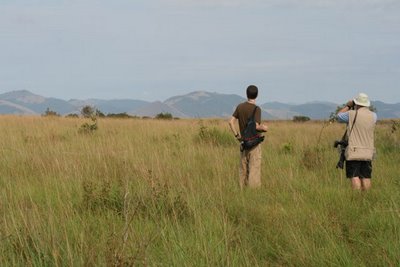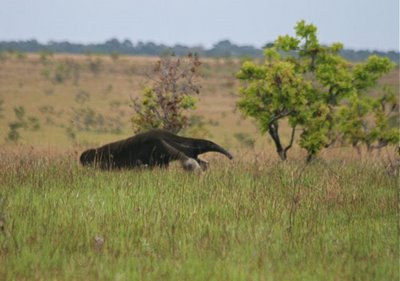Chasing the Giant Anteater
One of the oddest things about the giant anteater is its huge, sail-like tail. It uses the tail as a sun shade and umbrella when it sleeps in shallow depressions during the day. Extremely coarse, strawlike hair sheds water, and the fine, velour-like hair on its nose and face protects it from ant bites and stings. An odd bit of information: Anteater hair is highly flammable, and the animals are vulnerable to grass fires. What an awful thought.
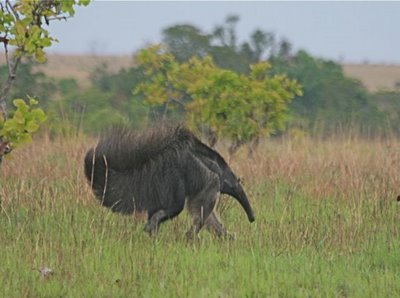
Though an adult's body is 3 1/2' long, its tongue can extend two more feet. It is detached from the hyoid bone and extends deep into the thorax to the breastbone! Coated with sticky saliva, the tongue lances into termite and ant mounds and instantly ensnares workers and larvae. It lashes forward and back, up to 150 times per minute, dragging the ants and termites to their demise. The anteater strikes and flees before the powerful soldier ants can mount an organized defense. As many as 30,000 insects may fall prey each day. No wonder a giant anteater's home range may cover more than 22,200 acres! Odder yet than its mobile tongue is its skull. The anteater has no jaws; its maxilla and mandible are fused into a single bony tube; thus it cannot open its mouth more than an inch or so. Imagine.
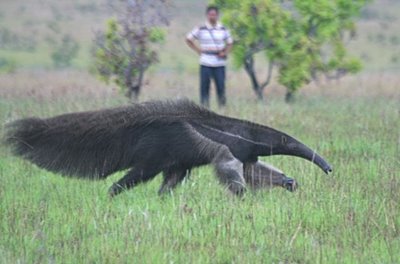
You can see his huge claws folded back along his wrists as he runs, mouth, such as it is, agape.
So as flabbergasted and delighted and agog as I was to have a giant anteater thunder right toward and then past me, I was immediately concerned for its welfare. The idea of routing it from its feeding or resting routine just so we could get a look at it didn't sit well with me. I couldn't see how this method of scaring up anteaters could be sustainable in the long run--wouldn't you drive them out of their habitat with such harrassment? I felt abashed that it had been so disturbed just for our entertainment. Imagine being forced to gallop on a hot morning, breathing through a snorkel, and you can see why we were so deeply concerned.
Ecotourism is in its infancy in Guyana, and having run with lightning speed over rough terrain and sent the anteater practically into our arms, our guides glowed with pride that they were able to give us such a thrilling experience. I couldn't fault them; they gave us what they thought we would want. They were great guys.
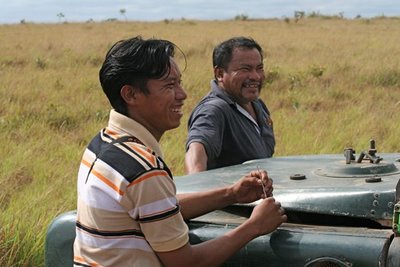 The nuances of watching wildlife without disturbing it have yet to enter into the equation in the isolated case of Karanambu's giant anteaters. (Everywhere else we went, wildlife was approached cautiously and with a great deal of respect. I suspect this driving approach is viewed as the only surefire way to give tourists a decent view of a reclusive mammal). How much more preferable it would have been for us to view the anteater at a distance, perhaps from an elevated platform with a spotting scope, than to stress it this way! Having no scope, the guides resorted to herding it. I can't think about my first, and perhaps only, sighting of this rare animal without a pang of guilt and shame. There has to be a better way. Individually and as a group, we expressed our distress to the trip organizers, pleading the anteater's side of things.
The nuances of watching wildlife without disturbing it have yet to enter into the equation in the isolated case of Karanambu's giant anteaters. (Everywhere else we went, wildlife was approached cautiously and with a great deal of respect. I suspect this driving approach is viewed as the only surefire way to give tourists a decent view of a reclusive mammal). How much more preferable it would have been for us to view the anteater at a distance, perhaps from an elevated platform with a spotting scope, than to stress it this way! Having no scope, the guides resorted to herding it. I can't think about my first, and perhaps only, sighting of this rare animal without a pang of guilt and shame. There has to be a better way. Individually and as a group, we expressed our distress to the trip organizers, pleading the anteater's side of things.Baby giant anteaters crawl up their mother's legs immediately after birth, to ride clinging to her chest, or astride her like a tiny jockey. Having no jaws with which to pick the baby up, the mother depends on the baby to position itself, and waits for it to cling to her before moving away. This photo from the National Zoo depicts a baby born there on July 24, 2007. Oh my goodness.
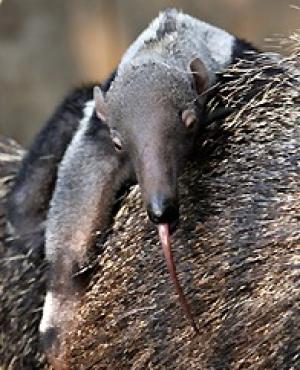 OK, do they nurse? My sources say they do, but how, if their tongues are long and snaky and they have no jaws? Arrggh. Need to know. Having just viewed some of the amazing giant anteater videos at Arkive.org, and seen the anteater's oral apparatus up close, I'm less concerned. I can imagine even this snaky-tongued youngster mustering up a pretty good vacuum with its tiny mouth. (Thanks, rmharvey!) Various sources have the young nursing from two to six months, riding on mama for up to nine months. Giant anteaters are thought to live up to 15 years in the wild, and have lived to 26 years in captivity.
OK, do they nurse? My sources say they do, but how, if their tongues are long and snaky and they have no jaws? Arrggh. Need to know. Having just viewed some of the amazing giant anteater videos at Arkive.org, and seen the anteater's oral apparatus up close, I'm less concerned. I can imagine even this snaky-tongued youngster mustering up a pretty good vacuum with its tiny mouth. (Thanks, rmharvey!) Various sources have the young nursing from two to six months, riding on mama for up to nine months. Giant anteaters are thought to live up to 15 years in the wild, and have lived to 26 years in captivity.Seaworld and Busch Gardens have a wonderful website , from which I garnered the following bit of animal trivia:
As an outcome of their diet and lifestyle, anteaters have relatively low metabolic rates. As a stark example, the giant anteater has the lowest recorded body temperature of any placental mammal--90.9 degrees F (32.7 degrees C).
When I read that, my heart sank. What do we know about the giant anteater's metabolism? What do we know about what happens when you chase a cool-blooded giant anteater around in stifling heat? Nothing. We know that that's a good way to get a close look at it. But...we also know that they're disappearing throughout their range; I've seen one estimate that places the global population at 5,000. We had seen one of that sadly dwindling number, and we had done him no good. Here comes the pang again.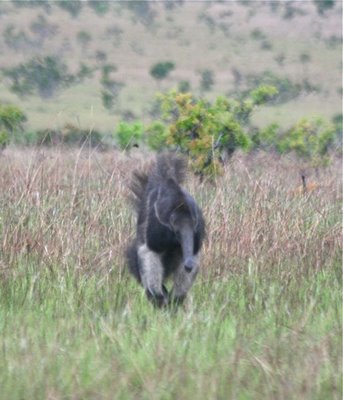
Like many wondrous animals, giant anteaters are disappearing, and are listed as Threatened/Vulnerable under CITES. At the very least, we owe it to them to admire them from a distance, to observe them living their lives undisturbed, to respect their dignity and their place on the planet, and leave them unharmed by our interest. May their glorious oddity, and our curiosity about them, not prove to be their demise.
When I read that, my heart sank. What do we know about the giant anteater's metabolism? What do we know about what happens when you chase a cool-blooded giant anteater around in stifling heat? Nothing. We know that that's a good way to get a close look at it. But...we also know that they're disappearing throughout their range; I've seen one estimate that places the global population at 5,000. We had seen one of that sadly dwindling number, and we had done him no good. Here comes the pang again.

Like many wondrous animals, giant anteaters are disappearing, and are listed as Threatened/Vulnerable under CITES. At the very least, we owe it to them to admire them from a distance, to observe them living their lives undisturbed, to respect their dignity and their place on the planet, and leave them unharmed by our interest. May their glorious oddity, and our curiosity about them, not prove to be their demise.
Labels: ecotourism in Guyana, giant anteater, giant anteater natural history, Guyana South America

